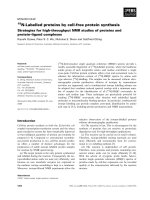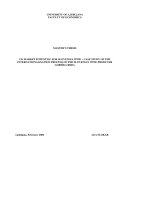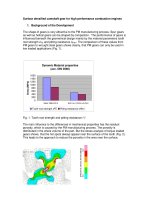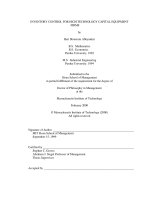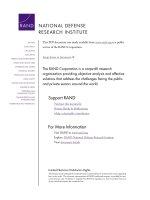laser bending for high precision curvature adjustment of microcantilevers
Bạn đang xem bản rút gọn của tài liệu. Xem và tải ngay bản đầy đủ của tài liệu tại đây (153.13 KB, 3 trang )
Laser bending for high-precision curvature adjustment of microcantilevers
X. Richard Zhang
a)
and Xianfan Xu
School of Mechanical Engineering, Purdue University, West Lafayette, Indiana 47907
(Received 19 August 2004; accepted 16 November 2004; published online 6 January 2005)
This work describes a laser based technique to adjust curvatures of silicon microcantilevers used for
chemical and biological detection. In batch fabricated silicon cantilever arrays used for parallel
sensing, it is often desirable that all cantilevers have nearly identical curvatures or flatness. We
demonstrate that using the laser technique, it is possible to adjust curvatures by an amount as small
as 3.5
rad, for cantilevers with a typical dimension of 110ϫ 13ϫ 0.6
m ͑lengthϫwidth
ϫ thickness͒. Different laser parameters can be applied in order to achieve the required curvature
adjustment. A two-dimensional finite element model of laser curvature adjustment is presented
which enables the prediction of the laser processing parameters. © 2005 American Institute of
Physics. [DOI: 10.1063/1.1851617]
The use of micromechanical cantilevers in an atomic
force microscope is a well-established application. Recently,
microcantilevers have been successfully used as extremely
sensitive physical, chemical, and biological sensors.
1–8
These
microcantilevers can be batch fabricated by photolithography
processes developed for integrated circuit manufacturing to-
gether with additional etching techniques.
9
For sensing ap-
plications, thin microcantilevers (less than 1
m) are desir-
able in order to obtain higher sensitivity. Consequently, these
microcantilevers are often very slender and compliant, vul-
nerable to external forces during fabrication processes in-
cluding final steps of releasing, handling, and device opera-
tion. For instance, thermal stresses, surface adhesion forces,
or tiny debris sitting on the cantilever tip can cause imper-
fection, resulting in undesired curvature of the microcantile-
ver, out-of-plane deformation or even adhesion to the under-
lying substrate.
10
On the other hand, the curvature or flatness
of a microcantilever is critical for microelectromechanical
systems or microsensors where the optical beam deflection
technique is used, i.e., a laser beam is focused onto the tip of
a microcantilever and the reflected beam is received by a
position sensing detector.
11
The microcantilever with an un-
desired downward-bent tip makes it difficult to be aligned
and obtain high sensitivity. For sensors using microcantilever
arrays,
4,5
identical curvatures of cantilevers are desirable.
Techniques for adjusting curvatures of individual cantilever
are needed.
Few methods have been developed to adjust curvature of
a microcantilever because silicon is a brittle material and is
hard to bend, and the dimensions of the microcantilevers are
small. Frühauf, Gärtner, and Jansch proposed plastic reshap-
ing of silicon microstructures.
12
However, their technique re-
quires homogeneous heating over 700 °C and special re-
shaping tools fabricated from silicon wafer as well as
microstructures. Gärtner and co-workers demonstrated that a
silicon microcantilever can be bent up to 90° by using a Nd:
yttrium–aluminum-garnet laser.
13
Ultrafast laser and nano-
second laser have been applied to repair microcantilevers
that adhered to the substrate.
10,14
In this work, we demonstrate a laser based technique for
high precision adjustment of microcantilevers. Unlike previ-
ous work involving lasers for repairing microcantilevers
that adhered to the substrate,
10,14
our technique is based on
producing a residual strain at the surface of the cantilever
material caused by the so-called temperature gradient
mechanism,
15
which is explained as follows. When the laser
beam irradiates the specimen surface, heating from the laser
produces a sharp temperature gradient in the thickness direc-
tion, causing the upper layer of the heated material to expand
more than the lower layers. Compressive stress and strain are
produced by the bulk constraint of the surrounding cooler
materials. Because of the high temperature achieved, plastic
deformations occur. During cooling, heat flows into the ad-
jacent area and the stress changes from compressive to ten-
sile due to thermal shrinkage. However, the compressive
strain generated during heating is not completely cancelled
because of the temperature dependent nonlinear mechanical
property of the material. As a result, the residual strain in the
laser-irradiated area is compressive after the target cools,
causing a permanent bending deformation toward the laser
beam. This theory of laser bending has been confirmed by a
number of studies by comparing the experimental data with
the results of finite element calculations, and detailed de-
scriptions of the theory can be found elsewhere.
16,17
a)
Author to whom correspondence should be addressed; electronic mail:
FIG. 1. SEM image of a silicon microcantilever (110
m long, 13
m
wide, and 0.6
m thick).
APPLIED PHYSICS LETTERS 86, 021114 (2005)
0003-6951/2005/86(2)/021114/3/$22.50 © 2005 American Institute of Physics86, 021114-1
Downloaded 05 Sep 2007 to 128.46.184.20. Redistribution subject to AIP license or copyright, see />The samples used in our work are silicon microcantile-
vers fabricated using merged epitaxial lateral overgrowth of
silicon followed by chemical mechanical polishing, which
have been used for sensitive chemical and biological
detection.
7,8
A scanning electron microscopy (SEM) image of
the microcantilever is shown in Fig. 1. The dimensions of the
microcantilever are 110
m long, 13
m wide, and 0.6
m
thick. In the laser bending experiment, the silicon wafer on
which the microcantilever is fabricated is clamped on a
three-dimensional (3D) motorized translation stage, as
shown in Fig. 2. In order to irradiate the laser beam on the
microcantilever precisely, a charge coupled device imaging
system is used. The objective lens has a long work distance
of about 20 mm. The same microscope objective lens is used
for focusing laser beam to obtain an 8-
m-diam laser spot
on the cantilever surface. The laser used is a pulsed fre-
quency doubled Nd:YLF laser with a wavelength of
524 mm, pulsewidth of 20 ns, and a repetition rate of 2 kHz.
The pulse energy varies from 0.18 to 0.32
J in the experi-
ment. The advantage of using the frequency doubled green
laser beam instead of its fundamental wavelength is that sili-
con has a much shorter optical absorption depth at the wave-
length of 524 nm than that at infrared ͑1.047
m͒.
14
The
optical beam deflection technique for measuring cantilever
bending is also shown in Fig. 2. A HeNe laser beam (the
dashed line) is focused onto the free end of the cantilever and
the reflected beam is received by a position sensing detector
(PSD). The PSD readings can be converted into microcanti-
lever bending angles after calibration. In the experiment, the
cantilever moves along the y direction on the motorized
stage at the constant speed of 250
m/s.
The measured bending angle versus the laser pulse en-
ergy is shown in Fig. 3. The bending angle increases when
the input laser pulse energy increases because high tempera-
ture and higher stress strain are produced with the use of
higher pulse energy. The microcantilever always bends to-
wards the laser beam direction, which agrees with the tem-
perature gradient mechanism. (This means that only down-
ward pre-curvature can be corrected, a limitation of this
technique.) The sensitivity of bending is about 3.5
rad. The
maximum bending angle obtained at these experimental set-
tings is 14
rad while using 0.3
J pulse energy and the
corresponding deflection at the microcantilever tip is about
1.3 nm. The surface of the cantilever melts when the laser
pulse energy is higher than 0.32
J. If a larger bending angle
is needed without melting the surface, one can scan multiple
lines on different locations of the cantilever. In this case, the
separations between the lines should be large enough so that
the residual strains caused by each line do not overlap with
each other. It is estimated from our calculation (see below)
and experiment that the residual strain field is about 10
m
wide. A total of eight lines can be applied to the cantilever of
110
m long, causing a maximum bending angle of
112
rad using laser energy of 0.3
J.
A finite element model is also developed to simulate the
laser bending of the microcantilever. This model computes
the laser induced heating, stress and strain development, and
the residual stress and strain. Details of thermal and stress
analyses in pulsed laser bending can be found elsewhere.
17,18
A single laser pulse with a uniform intensity across the width
of the specimen is assumed (the y direction in Fig. 2), i.e., a
line shape pulse is irradiated onto the sample surface. Thus, a
two-dimensional (2D) thermal-stress model can be applied.
The computed deflection contour of the cantilever is shown
in Fig. 4. For this calculation, the intensity of the line shape
pulse is 0.6 J/cm
2
, which is the same intensity for a 0.3
J
pulse focused in an 8
m diameter. The bending angle ob-
tained by simulation is 23.6
rad, which is larger than the
experimental data, 14
rad. The difference between the ex-
perimental and numerical results is mainly caused by the
simplified 2D model. This model simulates the laser pulses
scanning by using a line shape pulse. A three-dimensional
(3D) model calculating pulse by pulse will be more accurate.
However, the computational cost of calculating the total 100
pulses in a scan line is prohibitively time consuming.
In summary, we developed a highly sensitive laser bend-
ing technique for adjusting the curvature of microcantilevers.
Such a technique is simple to implement, yet very useful for
applications involving arrays of cantilevers for parallel
chemical and biological sensing.
The authors would like to thank Amit Gupta and Profes-
sor Rashid Bashir of Purdue University for supplying the
microcantilever samples. Support for this work by the Na-
tional Science Foundation is acknowledged.
FIG. 2. Schematic experimental setup of the laser bending system.
FIG. 3. Bending angle vs laser pulse energy (scan speed 250
m/s, laser
beam diameter 8
m).
FIG. 4. Deflection distribution of the microcantilever after laser bending
(laser pulse energy 0.32
J).
021114-2 X. R. Zhang and X. Xu Appl. Phys. Lett. 86, 021114 (2005)
Downloaded 05 Sep 2007 to 128.46.184.20. Redistribution subject to AIP license or copyright, see />1
K. Gimzewski, Ch. Gerber, E. Meyer, and R. R. Schlittler, Chem. Phys.
Lett. 217,589(1994).
2
G. U. Lee, L. A. Chrisey, and R. J. Colton, Science 266, 771 (1994).
3
S. C. Minne, S. R. Manalis, and C. F. Quate, Appl. Phys. Lett. 67, 3918
(1995).
4
J. Fritz, M. K. Baller, H. P. Lang, H. Rothuizen, P. Vettiger, E. Meyer,
H J. Güntherodt, Ch. Gerber, and J. K. Gimzeski, Science 288, 316
(2000).
5
C. A. Savran, T. P. Burg, J. Fritz, and S. R. Manalis, Appl. Phys. Lett. 83,
1659 (2003).
6
G. Wu, R. H. Datar, K. M. Hansen, T. Thundat, R. J. Cote, and A. Ma-
jumdar, Nat. Biotechnol. 19,856(2001).
7
R. Bashir, J. Z. Hilt, A. Gupta, O. Elibol, and N. A. Peppas, Appl. Phys.
Lett. 81, 3091 (2002).
8
A. Gupta, D. Akin, and R. Bashir, Appl. Phys. Lett. 84, 1976 (2004).
9
K. E. Peterson, Proc. IEEE 70, 420 (1982).
10
N. C. Tien, S. Jeong, L. M. Phinney, K. Fushinobu, and J. Bokor, Appl.
Phys. Lett. 68, 197 (1996).
11
G. Meyer and N. M. Amer, Appl. Phys. Lett. 53,1045(1988).
12
J. Frühauf, E. Gärtner, and E. Jansch, J. Micromech. Microeng. 9,305
(1999).
13
E. Gärtner, J. Frühauf, U. Loschner, and H. Exner, Microsystem Tech. 7,
23 (2001).
14
L. M. Phinney and J. W. Rogers, J. Adhes. Sci. Technol. 17,603(2003).
15
M. Geiger and F. Vollertsen, Annals CIRP 42, 301 (1993).
16
G. Chen, X. Xu, C. C. Poon, and A. C. Tam, Opt. Eng. (Bellingham) 37,
2837 (1998).
17
X. R. Zhang and X. Xu, J. Manuf. Sci. Eng. 125,512(2003).
18
X. R. Zhang and X. Xu, J. Appl. Mech. 71, 321 (2004).
021114-3 X. R. Zhang and X. Xu Appl. Phys. Lett. 86, 021114 (2005)
Downloaded 05 Sep 2007 to 128.46.184.20. Redistribution subject to AIP license or copyright, see />



